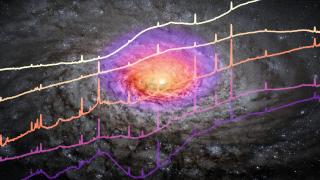Bibcode
Musiimenta, B.; Brusa, M.; Liu, T.; Salvato, M.; Buchner, J.; Igo, Z.; Waddell, S. G. H.; Toba, Y.; Arcodia, R.; Comparat, J.; Alexander, D.; Shankar, F.; Lapi, A.; Ramos Almeida, C.; Georgakakis, A.; Merloni, A.; Urrutia, T.; Li, J.; Terashima, Y.; Shen, Y.; Wu, Q.; Dwelly, T.; Nandra, K.; Wolf, J.
Referencia bibliográfica
Astronomy and Astrophysics
Fecha de publicación:
11
2023
Revista
Número de citas
15
Número de citas referidas
13
Descripción
Context. In the context of an evolutionary model, the outflow phase of an active galactic nucleus (AGN) occurs at the peak of its activity, once the central supermassive black hole (SMBH) is massive enough to generate sufficient power to counterbalance the potential well of the host galaxy. This outflow feedback phase plays a vital role in galaxy evolution.
Aims: Our aim in this paper is to apply various selection methods to isolate powerful AGNs in the feedback phase, trace and characterise outflows in these AGNs, and explore the link between AGN luminosity and outflow properties.
Methods: We applied a combination of methods to the Spectrum Roentgen Gamma (SRG) eROSITA Final Equatorial Depth survey (eFEDS) catalogue and isolated ∼1400 candidates at z > 0.5 out of ∼11 750 AGNs (∼12%). Furthermore, we narrowed down our selection to 427 sources that have 0.5 < z < 1. We tested the robustness of our selection on the small subsample of 50 sources with available good quality SDSS spectra at 0.5 < z < 1 and, for which we fitted the [OIII] emission line complex and searched for the presence of ionised gas outflow signatures.
Results: Out of the 50 good quality SDSS spectra, we identified 23 quasars (∼45%) with evidence of ionised outflows based on the presence of significant broad and/or shifted components in [OIII]λ5007 Å. They are on average more luminous (log Lbol ∼ 45.2 erg s−1) and more obscured (NH ∼ 1022 cm−2) than the parent sample of ∼427 candidates, although this may be ascribed to selection effects affecting the good quality SDSS spectra sample. By adding 118 quasars at 0.5 < z < 3.5 with evidence of outflows reported in the literature, we find a weak correlation between the maximum outflow velocity and the AGN bolometric luminosity. On the contrary, we recovered strong correlations between the mass outflow rate and outflow kinetic power with the AGN bolometric luminosity.
Conclusions: About 30% of our sample have kinetic coupling efficiencies, Ė/Lbol > 1%, suggesting that the outflows could have a significant effect on their host galaxies. We find that the majority of the outflows have momentum flux ratios lower than 20 which rules out an energy-conserving nature. Our present work points to the unequivocal existence of a rather short AGN outflow phase, paving the way towards a new avenue to dissect AGN outflows in large samples within eROSITA and beyond.
Aims: Our aim in this paper is to apply various selection methods to isolate powerful AGNs in the feedback phase, trace and characterise outflows in these AGNs, and explore the link between AGN luminosity and outflow properties.
Methods: We applied a combination of methods to the Spectrum Roentgen Gamma (SRG) eROSITA Final Equatorial Depth survey (eFEDS) catalogue and isolated ∼1400 candidates at z > 0.5 out of ∼11 750 AGNs (∼12%). Furthermore, we narrowed down our selection to 427 sources that have 0.5 < z < 1. We tested the robustness of our selection on the small subsample of 50 sources with available good quality SDSS spectra at 0.5 < z < 1 and, for which we fitted the [OIII] emission line complex and searched for the presence of ionised gas outflow signatures.
Results: Out of the 50 good quality SDSS spectra, we identified 23 quasars (∼45%) with evidence of ionised outflows based on the presence of significant broad and/or shifted components in [OIII]λ5007 Å. They are on average more luminous (log Lbol ∼ 45.2 erg s−1) and more obscured (NH ∼ 1022 cm−2) than the parent sample of ∼427 candidates, although this may be ascribed to selection effects affecting the good quality SDSS spectra sample. By adding 118 quasars at 0.5 < z < 3.5 with evidence of outflows reported in the literature, we find a weak correlation between the maximum outflow velocity and the AGN bolometric luminosity. On the contrary, we recovered strong correlations between the mass outflow rate and outflow kinetic power with the AGN bolometric luminosity.
Conclusions: About 30% of our sample have kinetic coupling efficiencies, Ė/Lbol > 1%, suggesting that the outflows could have a significant effect on their host galaxies. We find that the majority of the outflows have momentum flux ratios lower than 20 which rules out an energy-conserving nature. Our present work points to the unequivocal existence of a rather short AGN outflow phase, paving the way towards a new avenue to dissect AGN outflows in large samples within eROSITA and beyond.
Proyectos relacionados

Actividad Nuclear en Galaxias: una Perspectiva 3D del Núcleo y su Entorno
Nuestro proyecto puede dividirse en dos líneas principales de investigación. En primer lugar, el estudio de los vientos producidos por cuásares luminosos oscurecidos y del impacto que estos tienen en sus galaxias anfitrionas (retroalimentación del AGN). Para ello hemos obtenido observaciones en el óptico e infrarrojo cercano con el Gran Telescopio
Cristina
Ramos Almeida